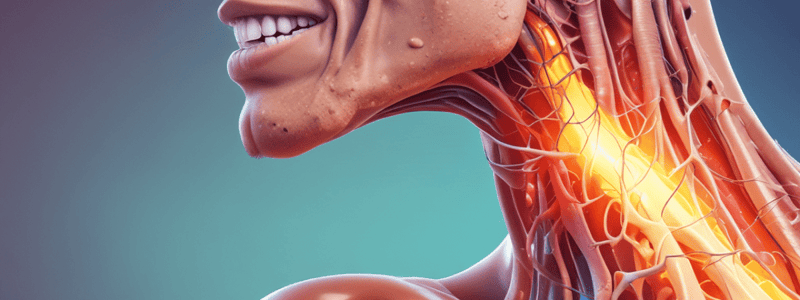Podcast
Questions and Answers
What is the medical specialty that deals with inflammation of muscles, bones, and joints?
What is the medical specialty that deals with inflammation of muscles, bones, and joints?
- Gastroenterology
- Neurology
- Endocrinology
- Rheumatology (correct)
What is the name of the inflammatory disorder that triggers inflammation in specific joints due to hyperuricemia?
What is the name of the inflammatory disorder that triggers inflammation in specific joints due to hyperuricemia?
- Lyme Disease
- Gout (correct)
- Osteomyelitis
- Myositis
Which condition is characterized by acute inflammation of the metatarsophalangeal joint of the great toe?
Which condition is characterized by acute inflammation of the metatarsophalangeal joint of the great toe?
- Podagra (correct)
- Rheumatoid Arthritis
- Myositis
- Osteomyelitis
What bacterial disease is transmitted by ticks and causes erythema migrans ('bull's-eye rash')?
What bacterial disease is transmitted by ticks and causes erythema migrans ('bull's-eye rash')?
What is the primary risk factor for developing bone infections according to the text?
What is the primary risk factor for developing bone infections according to the text?
Which type of gout may involve multiple joints and can be confused with Osteoarthritis (OA) and Rheumatoid Arthritis (RA)?
Which type of gout may involve multiple joints and can be confused with Osteoarthritis (OA) and Rheumatoid Arthritis (RA)?
What diagnostic method involves aspiration of joint fluid showing urate crystals as the gold standard for diagnosing a specific condition?
What diagnostic method involves aspiration of joint fluid showing urate crystals as the gold standard for diagnosing a specific condition?
Which medical condition is defined by >6-8 weeks duration or lack of response to treatment, leading to necrotic bone and increased gangrene risk?
Which medical condition is defined by >6-8 weeks duration or lack of response to treatment, leading to necrotic bone and increased gangrene risk?
What disease stage of Lyme Disease is characterized by vague symptoms, lymphocytic meningitis, and cranial neuritis?
What disease stage of Lyme Disease is characterized by vague symptoms, lymphocytic meningitis, and cranial neuritis?
What type of infection is caused by Staphylococcus aureus and affects the bone primarily?
What type of infection is caused by Staphylococcus aureus and affects the bone primarily?
Flashcards are hidden until you start studying
Study Notes
Musculoskeletal Infections and Inflammatory Disorders
- Musculoskeletal system is prone to various inflammatory disorders and infections
- Common inflammatory disorders include gout and rheumatoid arthritis
- Rheumatology deals with inflammation of muscles, bones, and joints
- Myositis is inflammation of the muscles, while osteomyelitis is inflammation of the bone usually due to infection
Osteomyelitis
- Bone is normally resistant to infection, but bacterial infections can occur due to breaks in the bone or spread from the bloodstream
- Risk factors for bone infections include immunosuppression, comorbid diseases like diabetes mellitus, nutritional deficiencies, and presence of prosthetic material
- Synovial fluid found in synovial joints, amount may increase in disease states
- Joint effusion refers to edema of the joint
- Limited blood supply makes it difficult to deliver medications, so intra-articular injection is preferred
- Osteomyelitis is an infection of the bone, usually caused by Staphylococcus aureus
- Sickle cell anemia patients are at risk for Salmonella osteomyelitis
Types of Osteomyelitis
- Hematogenous: rapid onset of symptoms, more common in children
- Contiguous: caused by trauma, surgery, or decubitus ulcers, more common in those with diabetes or peripheral vascular disease
- Chronic: defined by >6-8 weeks duration or lack of response to treatment, leads to necrotic bone and increased gangrene risk
Diagnosing Osteomyelitis
- Lab tests: CBC, ESR, C-RP
- Blood cultures are positive in only 50% of cases
- Culture and aspiration may fail to identify the pathogen
- Imaging: X-ray, CT scan, MRI
- Diagnosis can be challenging, requiring a combination of clinical presentation and diagnostic tests
Treating Osteomyelitis
- Antibiotic therapy: IV for 2-6 weeks, then oral
- Debridement of necrotic tissue
- Surgical drainage of abscesses
- Regular reevaluation of the patient for 2 years
- Removal of infected prosthesis may be necessary in some cases
Lyme Disease
- Bacterial disease caused by Borrelia burgdorferi, transmitted by ticks
- Incubation period of 7-14 days, fewer than 50% recall tick bite
- Erythema migrans ("bull's-eye rash") may develop
- Bacteria can disseminate throughout the body, infecting skin, heart, joints, eyes, nervous system
- Patients may present with arthralgia, myalgias, fatigue, and headache
Stages of Lyme Disease
- Early localized stage (3-30 days): fever, myalgias, erythema migrans
- Early disseminated stage (3-12 weeks): vague symptoms, lymphocytic meningitis, cranial neuritis, carditis, ocular involvement
- Late disseminated stage (months to years): severe joint pain, central nervous system involvement, polyradiculopathy
Diagnosing and Treating Lyme Disease
- Diagnosis based on symptoms, tick exposure, and lab tests (ELISA and Western blot)
- Single prophylactic dose of doxycycline for those with tick bite in endemic areas
- 10-21 day course of doxycycline for treatment
- Post-Lyme syndrome may occur, possibly due to prolonged immune response
Gout
- Hyperuricemia triggers inflammation, affecting specific joints like the first metatarsal
- Podagra: acute inflammation of the metatarsophalangeal joint of the great toe
- Primary and secondary forms of gout exist
- Uric acid crystals may be deposited in subcutaneous tissue ("tophi")
- Patients present with redness, warmth, swelling of the affected joint, often at night or early morning
Risk Factors for Gout
- Diet high in meat (purines)
- High alcohol consumption
- Obesity and yo-yo dieting
- Family history
- Chemotherapy, medications
Diagnosing and Treating Gout
- Chronic gout may involve multiple joints, can be confused with OA and RA
- Hyperuricemia may not be present, so should not be sole diagnostic criteria
- Aspiration of joint showing urate crystals is the gold standard for diagnosis
- Management involves treating acute attacks and preventing future attacks
- NSAIDs, colchicine, allopurinol are common treatments
Studying That Suits You
Use AI to generate personalized quizzes and flashcards to suit your learning preferences.




